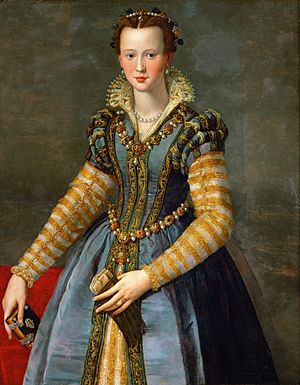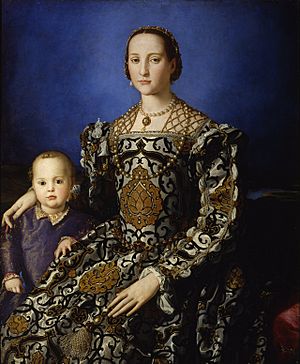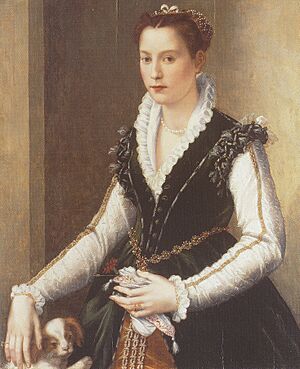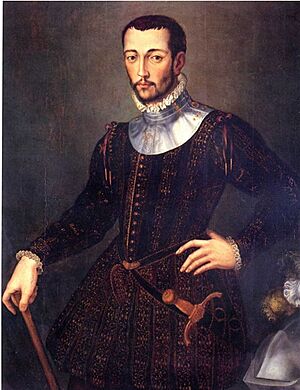Eleonora di Garzia di Toledo facts for kids
Quick facts for kids Eleonora di Garzia di Toledo |
|
|---|---|
 |
|
| Alessandro Allori, Eleonora ('Dianora') di Don Garzia di Toledo di Pietro de'Medici, circa 1571. | |
| Spouse(s) | Pietro de' Medici |
| Issue | |
| Cosimo de' Medici | |
| Noble family | House of Alba |
| Father | García Álvarez de Toledo y Osorio |
| Mother | Vittoria d'Ascanio Colonna |
| Born | March 1553 Florence, Duchy of Florence |
| Died | 10 July 1576 (aged 23) Villa Medici at Cafaggiolo, Grand Duchy of Tuscany |
Eleonora di Garzia di Toledo (March 1553 – 10 July 1576) was a noblewoman from a powerful Spanish family. She was also known as "Leonora" or "Dianora." Her father was García Álvarez de Toledo, 4th Marquis of Villafranca.
Leonora grew up in Florence at the court of Cosimo I de' Medici, Grand Duke of Tuscany and his wife, Eleanor of Toledo. Eleanor was Leonora's aunt and shared her name. At 15, Leonora was promised in marriage to Cosimo's son, Pietro.
She became close with Pietro's older sister, Isabella, who loved art. Leonora grew into a lively and clever young woman. Sadly, her marriage to Pietro was not happy. In 1576, Pietro took her to a country home called Cafaggiolo, where she died suddenly. Cosimo's son, Francesco I, who became the new Grand Duke, allowed Pietro to go unpunished.
For a long time, not much was known about Leonora. But recently, more has been discovered about her life. Her story helps us understand the lives of women in important courts during the early modern period in Italy.
Contents
Biography: A Young Noblewoman's Life

Early Life in Florence
Leonora was born in Florence in March 1553. Her parents were García Álvarez de Toledo y Osorio and Vittoria d'Ascanio Colonna. Her father was staying in Florence because he was in charge of castles in the Valdichiana region.
When Leonora's mother died a few months later, her aunt, Eleonora, the Grand Duchess of Florence, took care of her. Eleonora and Grand Duke Cosimo raised Leonora with love at the Medici court. She lived there for the rest of her life, like a menina (a girl trained for court life in the Spanish tradition).
Leonora's father, García Álvarez, became an important leader for Philip II of Spain. He served as the Viceroy of Catalonia and later the Viceroy of Sicily. He also commanded Philip's forces at the Battle of Lepanto in 1571. His family was part of the highest class of Spanish nobles called grandees.
In 1539, Leonora's aunt, Eleonora, married Cosimo I de' Medici. This marriage helped make the Medici family's rule stronger. Eleonora and Cosimo had 11 children. These included future grand dukes Francesco and Ferdinando, as well as Pietro and Isabella.
Growing Up at Court
After Eleonora, the Grand Duchess, died in 1562, Cosimo's daughter Isabella became the leading lady of Florence. Isabella also took over raising Leonora. Leonora had red hair and a natural charm. She was well-liked by the Medici family.
When she was five, Leonora comforted Cosimo's second daughter, Lucrezia. Lucrezia was sad when she was away from her husband. Lucrezia died in 1561, leaving Isabella as Cosimo's only surviving daughter.
Grand Duke Cosimo was very fond of Leonora and treated her like his own daughter. He liked her lively spirit and energy. She enjoyed riding horses and practicing with weapons. Sometimes, he gently reminded her to act with more grace.
Because the House of Medici and the Toledo family were close, a marriage was arranged. Leonora would marry Cosimo's son Pietro, who was about her age. They had grown up together. They were engaged in 1568 when Leonora was 15. Philip II of Spain approved the marriage. Leonora's father gave her a dowry of 40,000 gold ducats. They married at the Palazzo Vecchio in April 1571. On February 10, 1573, Leonora gave birth to a son named Cosimo, also called "Cosimino." He was the only male Medici heir in his generation until he died three years later in August 1576, one month after his mother.

Married Life and Challenges
Being married brought both good and bad things for Leonora. On one hand, it connected her to one of Europe's wealthiest families. She could stay at a court where women often had more freedom. On the other hand, Pietro was the most troubled of Cosimo's children. From a young age, he showed a difficult and cruel personality that worried his parents.
Because of this, their marriage was never a happy one. In this way, it was similar to the marriage of Isabella de' Medici, who became Leonora's close friend. Grand Duke Cosimo had married his daughter Isabella into the House of Orsini for political reasons. This helped strengthen his position in southern Tuscany.
Isabella chose not to live at her husband's castle. Instead, with Cosimo's permission, she stayed in Florence. She created an artistic gathering place at her Villa Baroncelli. Leonora became part of Isabella's group and was known for her beauty and lively personality. Like Isabella, she supported charities and the arts. She was a patron of the literary Accademia degli Alterati.
Grand Duke Cosimo allowed such behavior as long as it was discreet and the marriages still helped political goals. The husbands also lived largely separate lives.

A Change in Leadership
Things changed after Grand Duke Cosimo died in 1574. His successor, Grand Duke Francesco, was very different. Francesco was less social and tolerant than his father. He preferred to study science and often worked in his laboratory.
Unfortunately for Isabella and Leonora, their brother Francesco did not approve of their lifestyles as much as Cosimo had. While he wanted to keep good relations with their husbands' families, he was less willing to ignore their behavior. Leonora, being younger than Isabella, was sometimes less careful. Neither woman fully understood the danger they were in from the new Grand Duke.
Tragic End
On July 11, 1576, Pietro de' Medici sent a note to his brother, Grand Duke Francesco. He wrote from the Villa Medici at Cafaggiolo, saying: "Last night at six hours an accident occurred to my wife and she died." The next day, Francesco wrote to his brother Ferdinando that Leonora was found "suffocated."
In truth, Leonora's death was not an accident. Pietro was involved in her death, and Francesco knew about it. Leonora was 23 years old. Six days later, her close friend, Isabella de' Medici, also died suddenly at a Medici villa. Francesco announced his sister's death as an accident.
People in Florence knew that Leonora had died tragically. A diarist named Agostino Lapini wrote that she was "beautiful, gracious, genteel, becoming, charming, affable." He added that "above all had two eyes in her head which were like two stars in their beauty." She was buried simply.

At first, Grand Duke Francesco said Leonora died of a heart attack. But the Spanish, who were powerful, were upset about how a high-ranking Spanish noblewoman was treated. Under pressure, Francesco eventually admitted the truth. He wrote to Philip II of Spain, explaining that Pietro had taken her life because of her behavior.
Francesco's approval meant that Pietro was never punished for Leonora's death. Her brother, Pedro Álvarez de Toledo y Colonna, protested her death. However, about a year later, Francesco sent Pietro to the Spanish court. Pietro spent most of the rest of his life there, only visiting Florence to ask for money to pay his gambling debts. Francesco sent Pietro away hoping he would become more responsible.
Francesco died in 1587. Pietro died in 1604, still in debt and unchanged.
|


